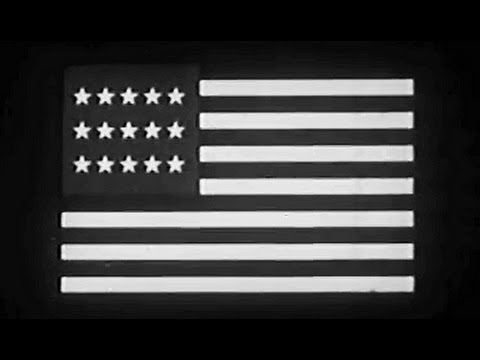more at
“Follows the evolution of the flag of the United States from the colonial flags to the stars and stripes of today. Shows by animation the development of the western territories into the present states and how this development effected changes in the flag. Narrator: Douglas Hamilton.”
Public domain film from the Prelinger Archive, slightly cropped to remove uneven edges, with the aspect ratio corrected, and mild video noise reduction applied.
The soundtrack was also processed with volume normalization, noise reduction, clipping reduction, and/or equalization (the resulting sound, though not perfect, is far less noisy than the original).
The national flag of the United States of America, often simply referred to as the American flag, consists of thirteen equal horizontal stripes of red (top and bottom) alternating with white, with a blue rectangle in the canton (referred to specifically as the “union”) bearing fifty small, white, five-pointed stars arranged in nine offset horizontal rows of six stars (top and bottom) alternating with rows of five stars. The 50 stars on the flag represent the 50 states of the United States of America and the 13 stripes represent the thirteen British colonies that declared independence from the Kingdom of Great Britain and became the first states in the Union. Nicknames for the flag include the “Stars and Stripes”, “Old Glory”, and “The Star-Spangled Banner…”
History
The design of the flag has been modified 26 times officially, since 1777. The 48-star flag was in effect for 47 years until the 49-star version became official on July 4, 1959. The 50-star flag was ordered by President Eisenhower on August 21, 1959…
At the time of the Declaration of Independence, the Continental Congress would not legally adopt flags with “stars, white in a blue field” for another year. The flag contemporaneously known as “the Continental Colors” has historically been referred to as the first national flag.
The Continental Navy raised the Colors as the ensign of the fledgling nation in the American War for Independence—likely with the expedient of transforming their previous British red ensigns by adding white stripes—and would use this flag until 1777, when it would form the basis for the subsequent de jure designs.
The name “Grand Union” was first applied to the Continental Colors by George Preble in his 1872 history of the American flag.
The flag closely resembles the British East India Company flag of the era, and Sir Charles Fawcett argued in 1937 that the Company flag inspired the design. Both flags could have been easily constructed by adding white stripes to a British Red Ensign, the maritime flag used throughout the British Empire. However, an East India Company flag could have from nine to 13 stripes, and was not allowed to be flown outside the Indian Ocean…
The Flag Resolution of 1777
On June 14, 1777, the Second Continental Congress passed the Flag Resolution which stated: “Resolved, That the flag of the thirteen United States be thirteen stripes, alternate red and white; that the union be thirteen stars, white in a blue field, representing a new constellation…”
The 1777 resolution was most probably meant to define a naval ensign. In the late 18th century, the notion of national flag did not yet exist…
The Flag Resolution did not specify any particular arrangement, number of points, nor orientation for the stars. One famous arrangement features 13 outwardly-oriented five-pointed stars arranged in a circle, the so-called Betsy Ross flag. Although the Betsy Ross legend is controversial, the design is among the earliest 13-star flags…
Despite the 1777 resolution, a number of flags only loosely based on the prescribed design were used in the early years of American independence…
The origin of the stars and stripes design is inadequately documented. The apocryphal story credits Betsy Ross for sewing the first flag from a pencil sketch handed to her by George Washington. No evidence for this exists; indeed, nearly a century had passed before Ross’ grandson, William Canby, first publicly suggested it…
It is clear that Francis Hopkinson of New Jersey, a signer of the Declaration of Independence, designed the 1777 flag while he was the Chairman of the Continental Navy Board’s Middle Department, sometime between his appointment to that position in November 1776 and the time that the flag resolution was adopted in June 1777. This contradicts the Betsy Ross legend, which suggests that she sewed the first Stars and Stripes flag by request of the government in the Spring of 1776…

